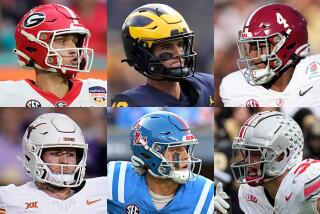AP Football Poll Was Invented Just ‘To Keep the Pot Boiling’
- Share via
When Alan J. Gould, AP sports editor, began ranking college football teams in 1935, he was just looking to stir things up a little.
“It was a case of thinking up ideas to develop interest and controversy between football Saturdays,” said Gould, who died this year at the age of 95. “Papers wanted material to fill space between games. That’s all I had in mind, something to keep the pot boiling. Sports then was living off controversy, opinion, whatever. This was just another exercise in hoopla.”
Gould’s one-man “exercise” caught on. Fifty-eight years later, the AP poll is as much a part of college football games as marching bands and team mascots. It’s one of AP’s most popular and talked-about features; because there are no college football playoffs, a No. 1 ranking at the end of the season is considered tantamount to winning a national championship.
And, as Gould had hoped, the poll has engendered its share of controversy. Should Notre Dame have won a national championship by settling for a tie with Michigan State? Should undefeated Clemson and Brigham Young have won the national championship despite playing weak schedules? Who was the better team in 1991--Miami or Washington? (Miami was, according to the AP poll--by four votes.)
There was even one week when Gould was even hung in effigy in a small town in Minnesota for failing to make the Gophers No. 1.
Over the years, the poll has undergone many changes. It began informally, with Gould ranking the top 10 teams himself, occasionally asking the advice of other AP staffers and friends.
“Making it a top 10 was an arbitrary decision,” Gould said. “It seemed logical to confine it to that number. It was tough enough to pick a top 10 in those days, let alone 15 or 20.”
The poll later was expanded to 20. It reverted to a Top 10 in 1961, expanded again to 20 teams in 1968, and grew to 25 in 1989, where it stands now.
The most notable change, though, is the way the teams are chosen. A year after Gould released his first final poll--he divided the No. 1 spot among 8-0 Minnesota, 9-0 Princeton and 12-0 Southern Methodist, pleasing none--the AP threw voting open to all members. On Oct. 19, 1936, the “official” AP poll made its formal debut with Minnesota ranked No. 1 with 32 first-place votes. (No. 2 Duke, No. 3 Army and No. 6 USC also received first-place votes.)
In 1960, voting was limited to a panel of voters--48 sports writers and broadcasters chosen by AP. The panel has since grown to 62 voters, spread across every region of the country.
Some notable firsts:
--First unanimous No. 1--Minnesota in 1936, sweeping all 44 first-place votes after recording its fourth straight victory and third consecutive shutout.
--First tie for No. 1--Texas A&M; and USC, both with 939 points in the Nov. 27, 1939, poll. The Aggies had 27 first-place votes and the Trojans 35.
--First game between No. 1 and No. 2--No. 1 Notre Dame vs. No. 2 Michigan on Oct. 9, 1943. Notre Dame won, 35-12.
--First team to be ranked No. 1 for the entire season--Notre Dame in 1943. That was the first of a record eight national championships for the Irish, four of them under coach Frank Leahy. Only Bear Bryant, with five at Alabama, has won more.
--First preseason poll--Introduced in 1950, with Notre Dame ranked No. 1. Oklahoma would finish first that year by the largest margin in the history of the final poll. The Sooners ended with 2,963 points, 583 ahead of Army. The closest final margin was after the 1991 season, when Miami won its fourth national championship with 1,472 points, just four ahead of Washington.
--First postseason poll--The final 1965 poll, taken after the bowl games. Alabama took advantage of the change to win the national championship, moving from No. 4 to No. 1 after beating Nebraska 39-28 in the Orange Bowl. For the next three years, the final poll came at the end of the regular season, but since 1968 voters have cast their final votes after the bowls.
No team has held the No. 1 ranking from start to finish since the preseason poll was instituted. The closest was Nebraska, which led every week in the 1983 season before losing to national champs Miami 31-30 in the Orange Bowl.
In 1971, Nebraska was No. 2 in the preseason poll and took over the top spot the next week; the Cornhuskers stayed No. 1 right through the final poll. The next year, USC rose from No. 8 in the preseason poll to lead every week en route to a national championship.
Nebraska has the longest streak in the rankings: 189 consecutive poll places from Oct. 5, 1981, through the final 1992 poll. That was preceded by a streak of 47 consecutive appearances, dating back to 1978. Despite all that success, Nebraska has won only two national championships, in 1970 and 1971.
--First repeat champions--Minnesota in 1940 and 1941. That gave coach Bernie Bierman three titles. He’s tied with John McKay of USC and Barry Switzer and Bud Wilkinson, both of Oklahoma.
More to Read
Go beyond the scoreboard
Get the latest on L.A.'s teams in the daily Sports Report newsletter.
You may occasionally receive promotional content from the Los Angeles Times.










